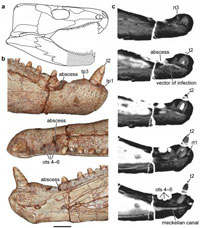The oldest known case of toothache discovered in reptile
A reptile that lived 275 million years ago in what is now Oklahoma is giving paleontologists an insight into the world’s oldest known toothache. A team of scientists, led by Prof. Robert Reisz, the chair of the Department of Biology at the University of Toronto Mississauga, have found clear evidence of bone damage due to oral infection in a Paleozoic reptile.
Human parallels
This discovery predates the previous record for oral and dental disease in a terrestrial vertebrate by nearly 200 million years. "Not only does this fossil extend our understanding of dental disease, it reveals the advantages and disadvantages that certain creatures faced as their teeth evolved to feed on both meat and plants," says Reisz. "In this case, as with humans, it may have increased their susceptibility to oral infections."
The researchers investigated the jaws of several well-preserved specimens of Labidosaurus hamatus, a 275-million-year-old terrestrial reptile from North America. One specimen stood out because of missing teeth and associated erosion of the jaw bone.
With the aid of CT-scanning, Reisz and his colleagues found evidence of a massive infection. This resulted in the loss of several teeth, as well as bone destruction in the jaw in the form of an abscess and internal loss of bone tissue.
As the ancestors of advanced reptiles adapted to life on land, many evolved dental and cranial specializations to feed more efficiently on other animals and to incorporate high-fiber plant leaves and stems into their diet. The primitive dental pattern, in which teeth were loosely attached to the jaws and continuously replaced, changed in some animals.
A new arrangement
Teeth then became strongly attached to the jaw, with little or no tooth replacement. This was clearly advantageous to some early reptiles, allowing them to chew their food and thus improve nutrient absorption. The abundance and global distribution of Labidosauris and its kin suggest that it was an evolutionary success.
However, Reisz and his colleagues suggest that as this reptile lost the ability to replace teeth, so the likelihood of infections of the jaw, resulting from damage to the teeth, increased substantially. This is because prolonged exposure of the dental pulp cavity of heavily worn or damaged teeth to oral bacteria was much greater than in other animals that quickly replaced their teeth.
Reisz notes that human susceptibility to oral infection has some parallels to those of ancient reptiles that evolved to eat a diet incorporating plants in addition to meat. "Our findings suggest that our own human system of having just two sets of teeth, baby and permanent, although of obvious advantage because of it allows us to chew and process many different types of food, is more susceptible to infection than that of our distant ancestors that had a continuous cycle of tooth replacement."
Reference: Robert R. Reisz, Diane M. Scott, Bruce R. Pynn, Sean P. Modesto. Osteomyelitis in a Paleozoic reptile: ancient evidence for bacterial infection and its evolutionary significance. Naturwissenschaften, 2011; DOI: 10.1007/s00114-011-0792-1


